Physical Address
304 North Cardinal St.
Dorchester Center, MA 02124
As indicated by its relative size (about 10% of the weight of the central nervous system), the cerebellum is essential to central nervous system function. However, it executes these responsibilities in unique ways. First, it receives extensive sensory input, but it is not involved in sensory discrimination or interpretation. Second, although it profoundly influences motor function, lesions of relatively large portions of the cerebellar cortex do not result in lasting motor deficits unless the area of damage also includes portions of the cerebellar nuclei. The patient may have uncoordinated movements, but when tested for strength, the patient is not weak. Large lesions of the cerebellum that involve the cortex plus nuclei may result in significant motor deficits (seen as asynergistic movements) but not in paralysis. Third, lesions of the cerebellum may result in deficits in motor learning and higher mental function.
The cerebellum is composed of a highly convoluted cerebellar cortex and a core of white matter containing the cerebellar nuclei. This structure is anchored to the brainstem via the cerebellar peduncles. The cerebellum is located superior to the brainstem, inferior to the tentorium cerebelli, and internal to the occipital bone. The cerebellum has a superior surface apposed to the inferior surface of the tentorium and a convex inferior surface that abuts the inner surface of the occipital bone.
The cerebellum receives input from many areas of the neuraxis and influences motor performance through connections with the dorsal thalamus and, ultimately, the motor cortices. Lesions of these pathways result in characteristic motor dysfunctions, which may involve either proximal (axial) or distal musculature. These deficits are actually the result of altered activity in the motor cortex and its descending brainstem and spinal projections, which influence lower motor neurons of the spinal cord.
The cerebellum is connected to the brainstem by three pairs of cerebellar peduncles ( Fig. 27.1 A- C ). The inferior cerebellar peduncle is composed of a larger part, the restiform body, and a smaller portion, the juxtarestiform body ( Fig. 27.1 B, C ). The restiform body is the large ridge on the dorsolateral aspect of the medulla rostral to the level of the obex. This bundle contains mainly fibers that arise in the spinal cord or medulla. The juxtarestiform body is located in the wall of the fourth ventricle. This bundle is composed primarily of fibers that form reciprocal connections between the cerebellum and vestibular structures ( Table 27.1 ).
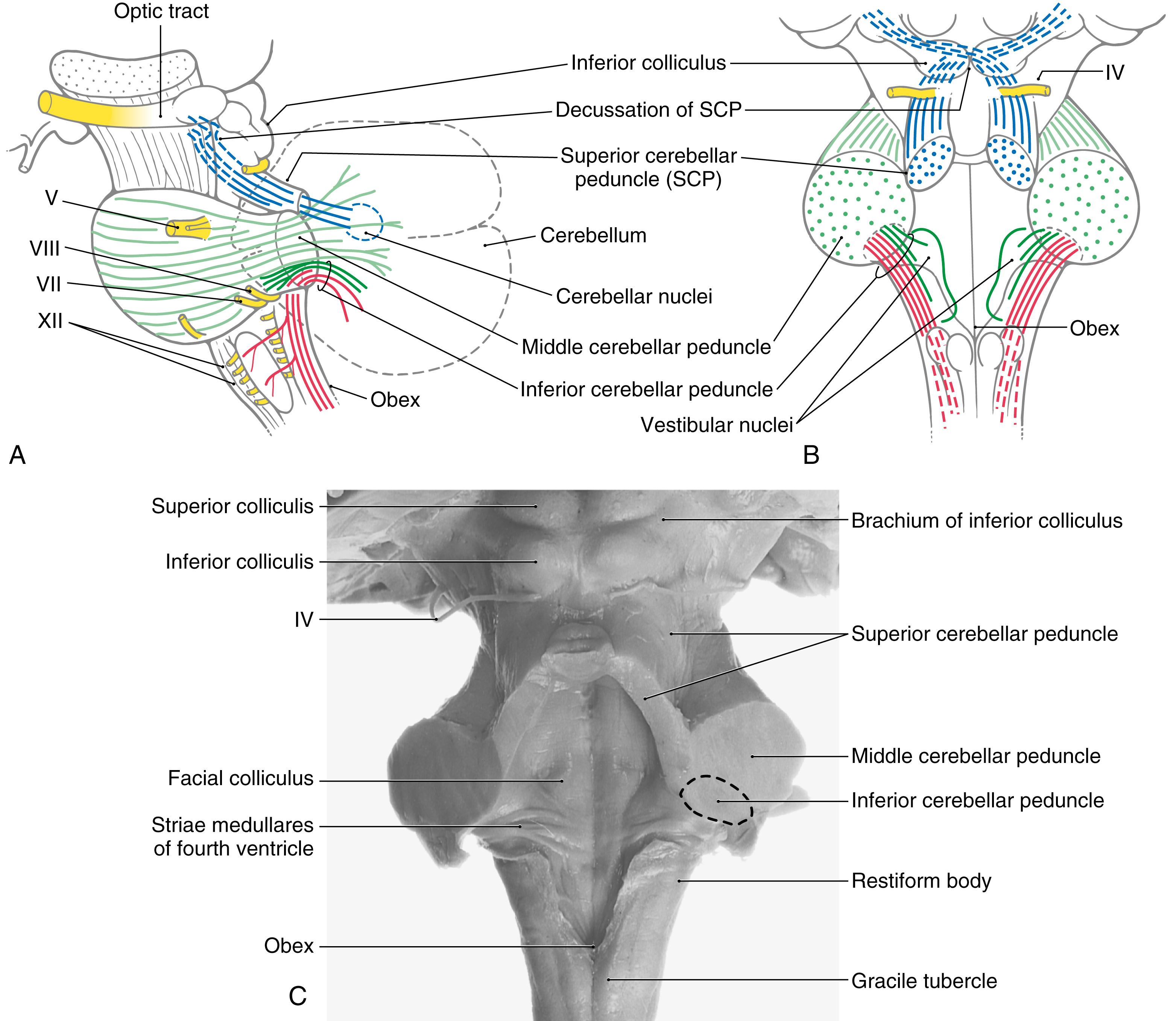
| Cerebellar Peduncles | Laterality | Afferents, Efferents |
|---|---|---|
| Inferior Cerebellar Peduncle | ||
| Restiform Body | ||
| Dorsal spinocerebellar fibers | − | Mossy fibers |
| Cuneocerebellar fibers | − | Mossy fibers |
| Olivocerebellar fibers | X | Climbing fibers |
| Reticulocerebellar fibers (from reticulotegmental pontine nucleus) | X, − | Mossy fibers |
| Reticulocerebellar fibers (from lateral reticular nucleus) | −, (X) | Mossy fibers |
| Reticulocerebellar fibers (from paramedian reticular nucleus) | −, (X) | Mossy fibers |
| Trigeminocerebellar fibers | − | Mossy fibers |
| Raphecerebellar fibers | −, (X) | Multilayered fibers |
| Juxtarestiform Body | ||
| Vestibulocerebellar fibers (primary and secondary) | − | Mossy fibers |
| Cerebellar corticovestibular fibers | − | Vestibular nuclei |
| Fastigiovestibular fibers | −, X | Vestibular nuclei |
| Fastigioreticular fibers | −, X | Reticular nuclei |
| Fastigioolivary fibers | X | Caudal parts of accessory olivary nuclei |
| Fastigiospinal fibers | X | Spinal cord |
| Middle Cerebellar Peduncle | ||
| Pontocerebellar fibers | X, (−) | Mossy fibers |
| Raphecerebellar fibers | −, (X) | Multilayered fibers |
| Superior Cerebellar Peduncle | ||
| Ventral spinocerebellar fibers | X, − | Mossy fiber |
| Rostral spinocerebellar fibers | X, − | Mossy fiber |
| Ceruleocerebellar fibers | −, X | Multilayered fibers |
| Hypothalamocerebellar fibers | −, X | Multilayered fibers |
| Raphecerebellar fibers | − | Multilayered fibers |
| Cerebellar efferent fibers | ||
| Dentatothalamic | X | Dorsal thalamus |
| Dentatorubral | X | Red nucleus |
| Dentatoreticular | X | Reticular nuclei |
| Dentatopontine | X | Pontine nuclei |
| Dentatoolivary | X | Principal olivary nucleus |
| Dentatohypothalamic | X | Hypothalamus |
| Interpositothalamic | X | Dorsal thalamus |
| Interpositorubral | X | Red nucleus |
| Interpositoreticular | X | Reticular nuclei |
| Interpositoolivary | X | Rostral parts of accessory olivary nuclei |
| Interpositohypothalamic | X | Hypothalamus |
| Interpositospinal | X | Spinal cord |
The basilar pons, which is located inferior to the exiting roots of the trigeminal nerve, is continuous into the middle cerebellar peduncle ( brachium pontis ), which is located superior (dorsal) to the exiting roots of the fifth cranial nerve ( Figs. 27.1 A-C and 27.2 ). These exiting roots represent the boundary between the basilar pons and the middle cerebellar peduncle. This large peduncle mainly conveys pontocerebellar fibers arise from the pontine nuclei of the basilar pons and enter the cerebellum.
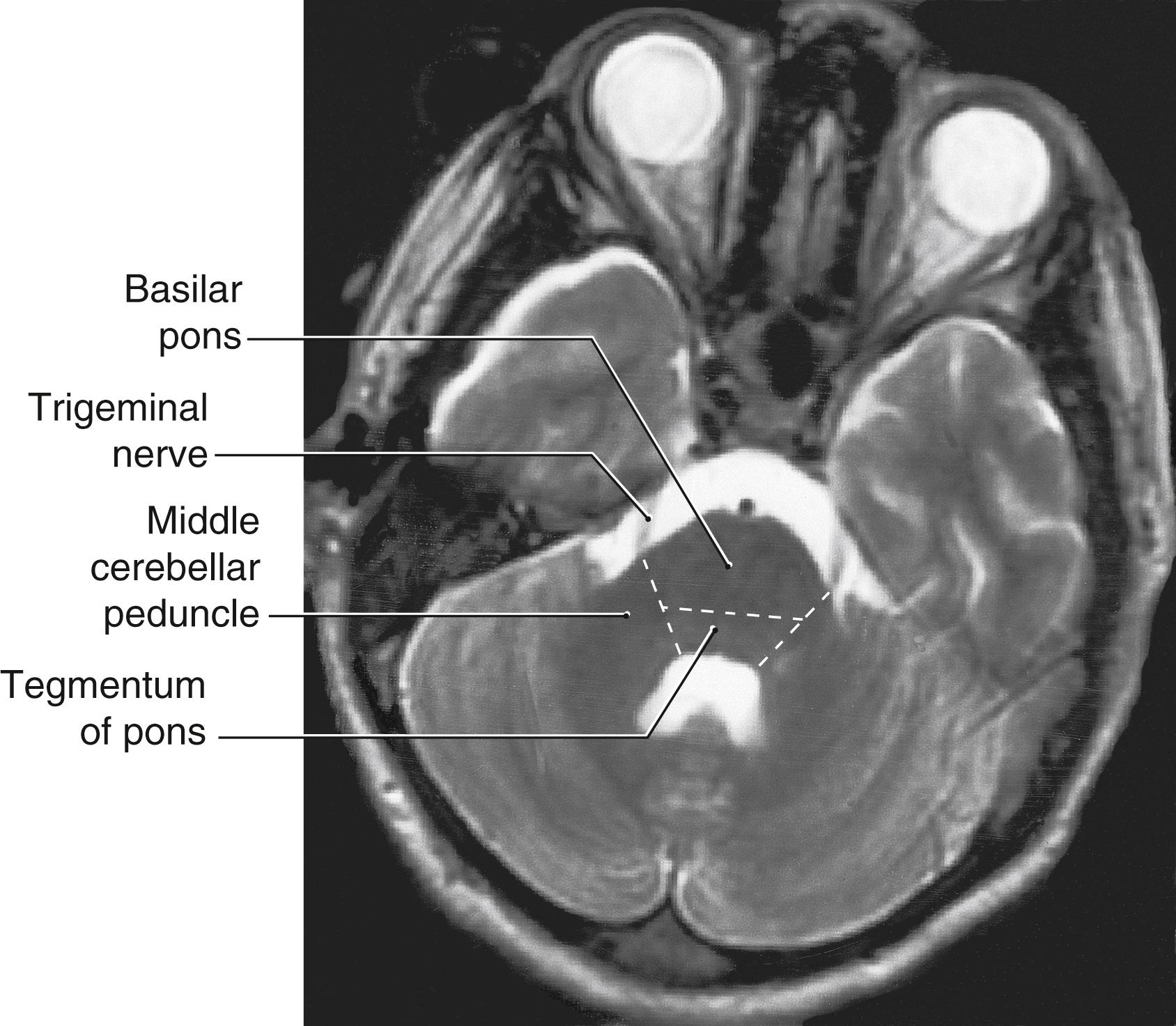
The superior cerebellar peduncle ( brachium conjunctivum ) sweeps rostrally out of the cerebellum and penetrates into the midbrain just caudal to the exit of the trochlear nerve ( Fig. 27.1 A- C ). Within the midbrain, these fibers cross the midline as the decussation of the superior cerebellar peduncle at the level of the inferior colliculus. This bundle contains predominantly cerebellar efferent fibers that originate from neurons of the cerebellar nuclei and distribute to the diencephalon and brainstem.
At the most general level, it is common to divide the cerebellum into a narrow midline vermis and expansive lateral hemispheres ( Figs. 27.3 and 27.4 [see pp. 397–398 ]). The cerebellum is further divided into anterior, posterior, and flocculonodular lobes by the primary and posterolateral fissures, respectively. The lobes of the cerebellum are composed of yet smaller divisions called lobules ( Figs. 27.3 and 27.5 [see pp. 397–399 ]). The lobules of the vermis are identified by Roman numerals I to X; the corresponding lateral (hemisphere) portion of each vermis lobule is identified by the same Roman numeral but with the prefix H ( Figs. 27.3 and 27.5 ). Vermis lobules II to X have hemisphere portions HII to HX ( Fig. 27.5 ); lobule I does not have a hemisphere part in humans. The anterior lobe comprises lobules I to V and HII to HV, and the posterior lobe, lobules VI to IX and HVI to HIX. The flocculonodular lobe consists of the nodulus ( lobule X ) and its hemisphere counterpart, the flocculus ( lobule HX ). In turn, each lobule consists of a series of individual ridges of cortex called folia (singular, folium ) ( Fig. 27.4 ).
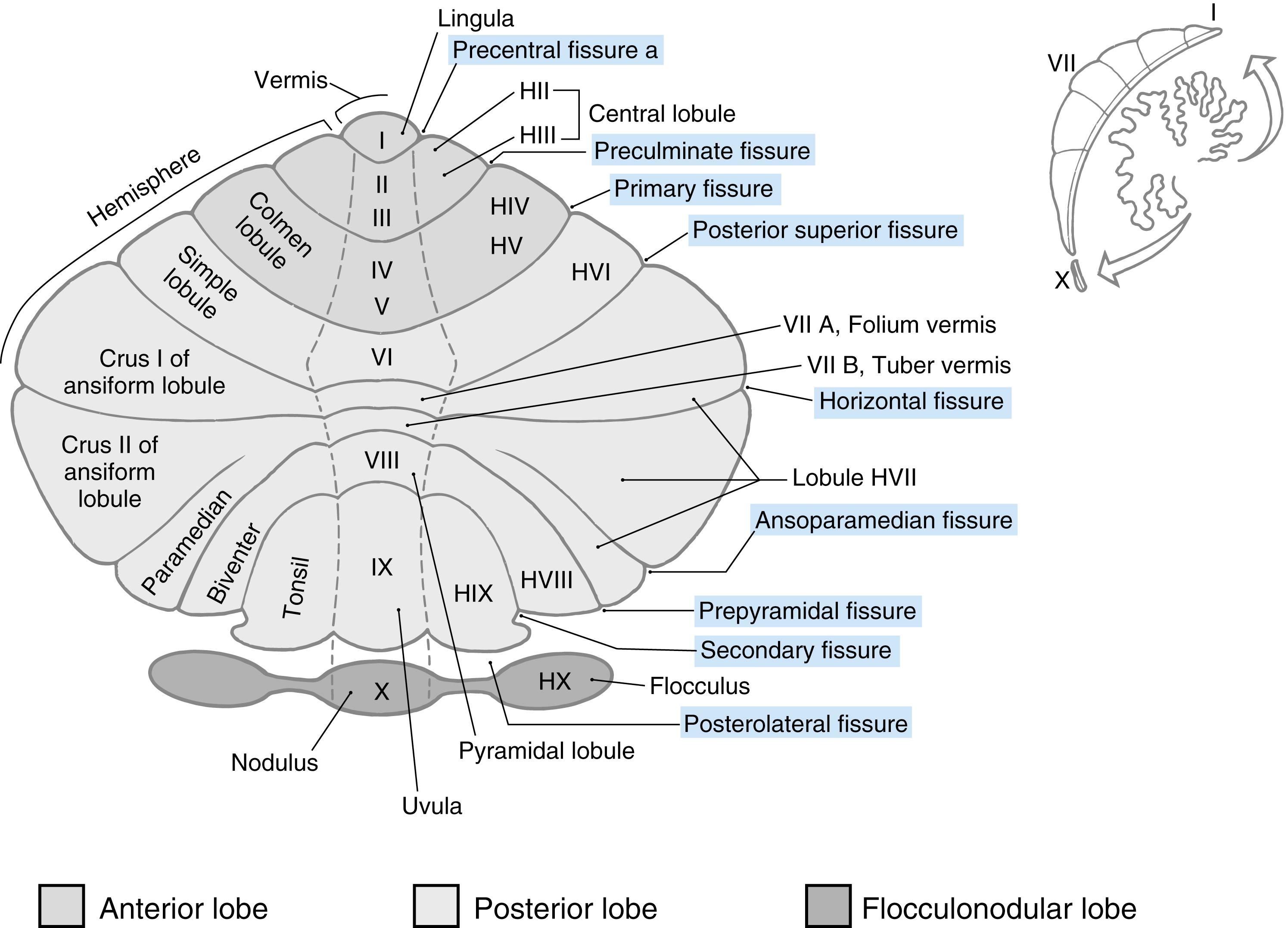
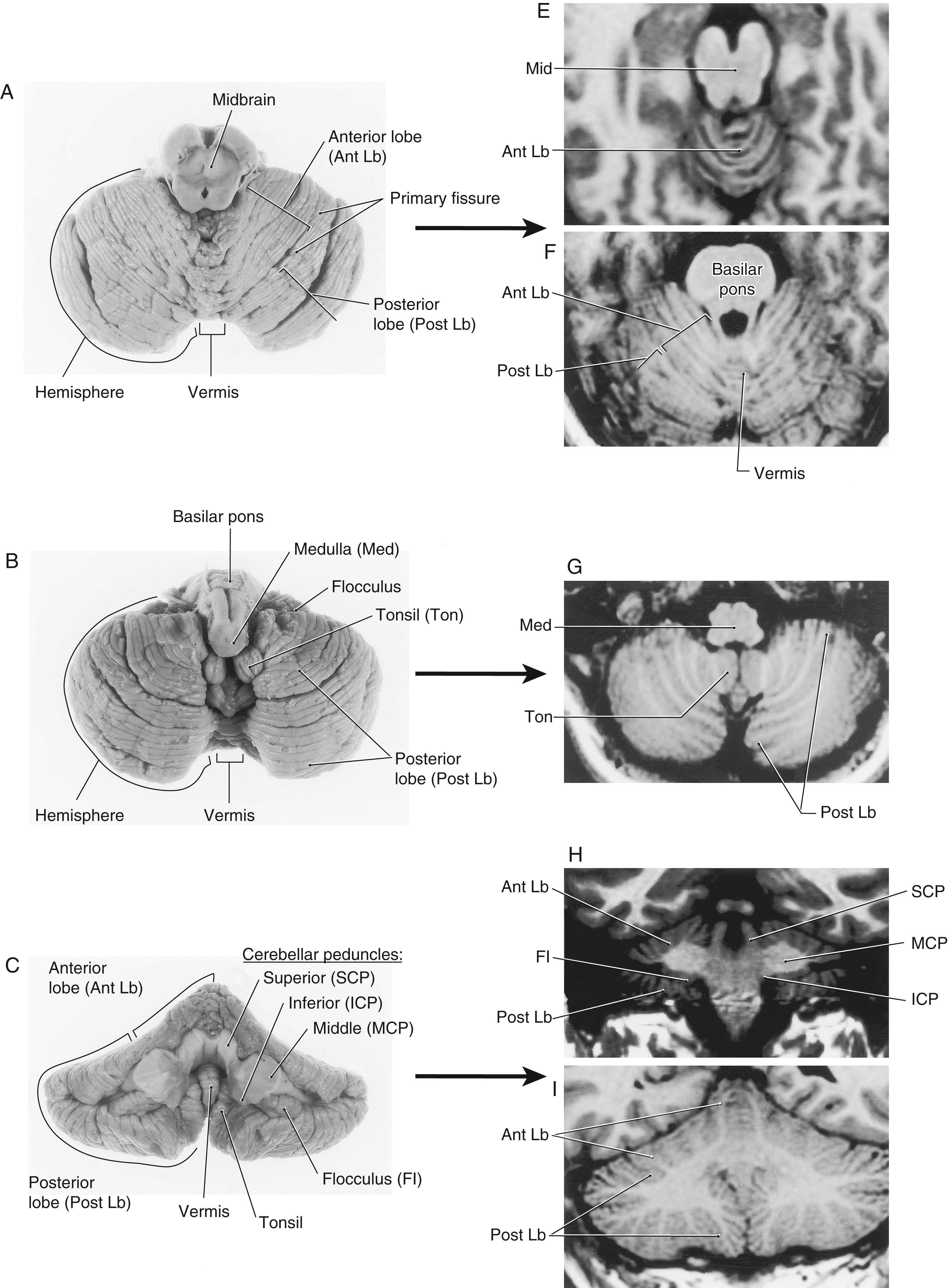
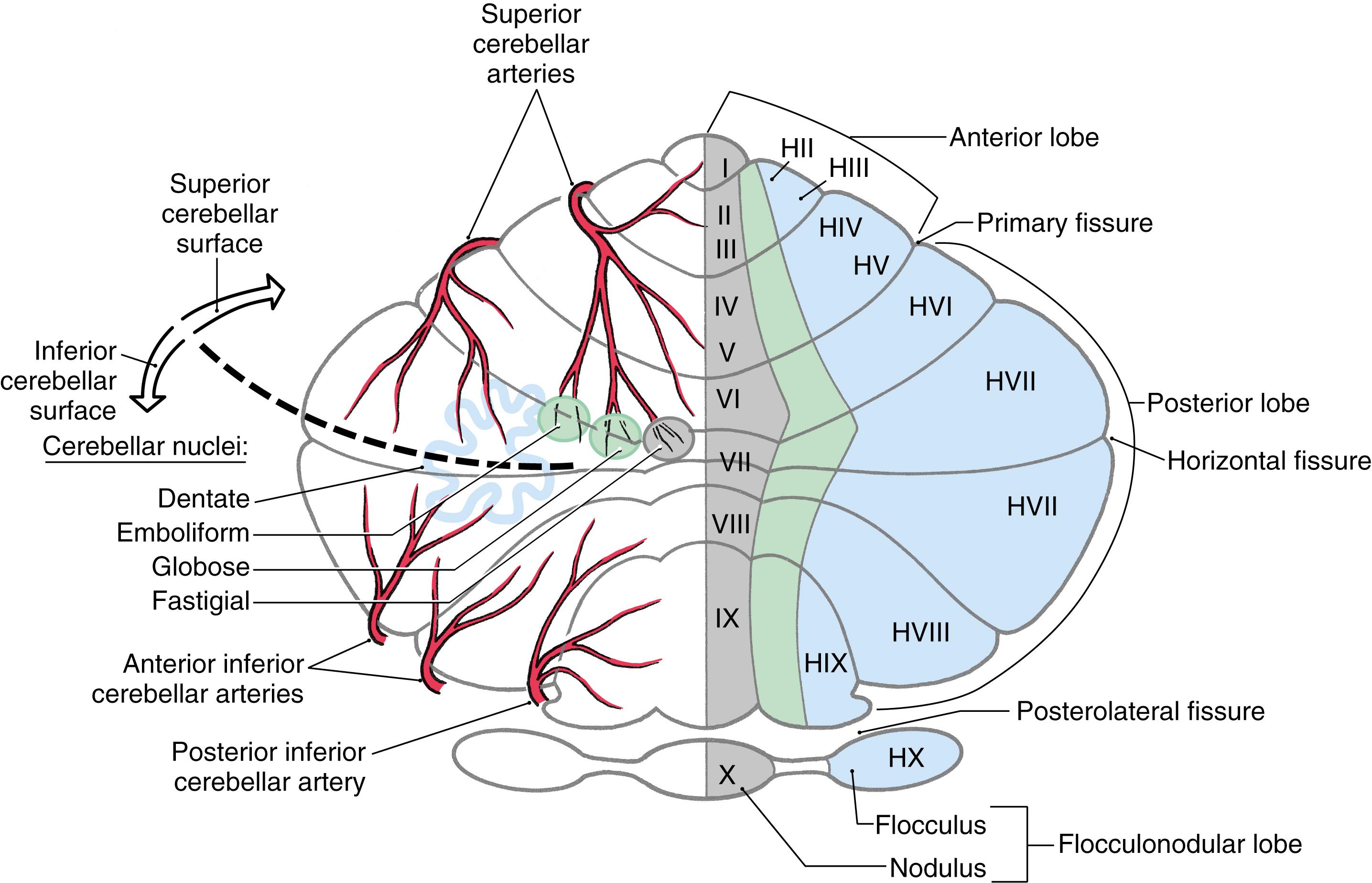
The individual folia are continuous from one hemisphere to the other, across the midline on the superior cerebellar surface ( Fig. 27.4 A, E, F ). This pattern, obvious on the superior cerebellar surface, is disrupted on the inferior surface by the enlargement of the lateral parts of the cerebellum and consequent infolding of the midline area ( Fig. 27.4 B, G, I ).
Superimposed on the lobes and lobules of the cerebellum are rostrocaudally oriented cortical zones that are defined on the basis of their connections. There are three principal zones on each side: the medial ( vermal ), intermediate ( paravermal ), and lateral ( hemisphere ) zones ( Fig. 27.5 ). On the basis of their afferent and efferent connections, these three larger cortical zones can be subdivided further into nine smaller zones. In general, these zone patterns are the basis for the modules discussed later in this chapter. The clinical deficits that result from a cerebellar lesion depend mainly on which of the three principal zones is involved; consequently, the three-zone terminology is used in this chapter.
The medial ( vermal ) zone is a narrow strip of cortex adjacent to the midline that extends throughout anterior and posterior lobes and includes the nodulus ( Figs. 27.4 A, B and 27.5 ). This zone is widest in lobule VI and tapers rostrally and caudally. The intermediate ( paravermal ) zone lies adjacent to the medial zone and extends throughout anterior and posterior lobes but has little representation in the flocculonodular lobe ( Fig. 27.5 ). The lateral ( hemisphere ) zone occupies by far the largest part of the cerebellar cortex. It includes large portions of anterior and posterior lobes and the flocculus ( Figs. 27.3 and 27.5 ).
The four pairs of cerebellar nuclei are located within the white matter core of the cerebellum and are accessed easily by fibers traveling to and from the overlying cortex ( Figs. 27.5 and 27.6 ). The fastigial ( medial cerebellar ) nucleus lies immediately adjacent to the midline and is functionally related to the overlying medial zone of the cerebellar cortex. Lateral to the fastigial nucleus are the two interposed nuclei: the globose ( posterior interposed ) nucleus and the emboliform ( anterior interposed ) nucleus. These nuclei are functionally related to the overlying intermediate zone of the cortex. Lateral to the emboliform nucleus is the dentate ( lateral cerebellar ) nucleus, which appears as a large, undulating sheet of cells shaped like a partially crumpled paper bag. Its opening, the hilus, is directed anteromedially ( Fig. 27.6 ). This nucleus is functionally related to the overlying lateral zone of the cortex; its large size correlates with the large size of this cortical zone.
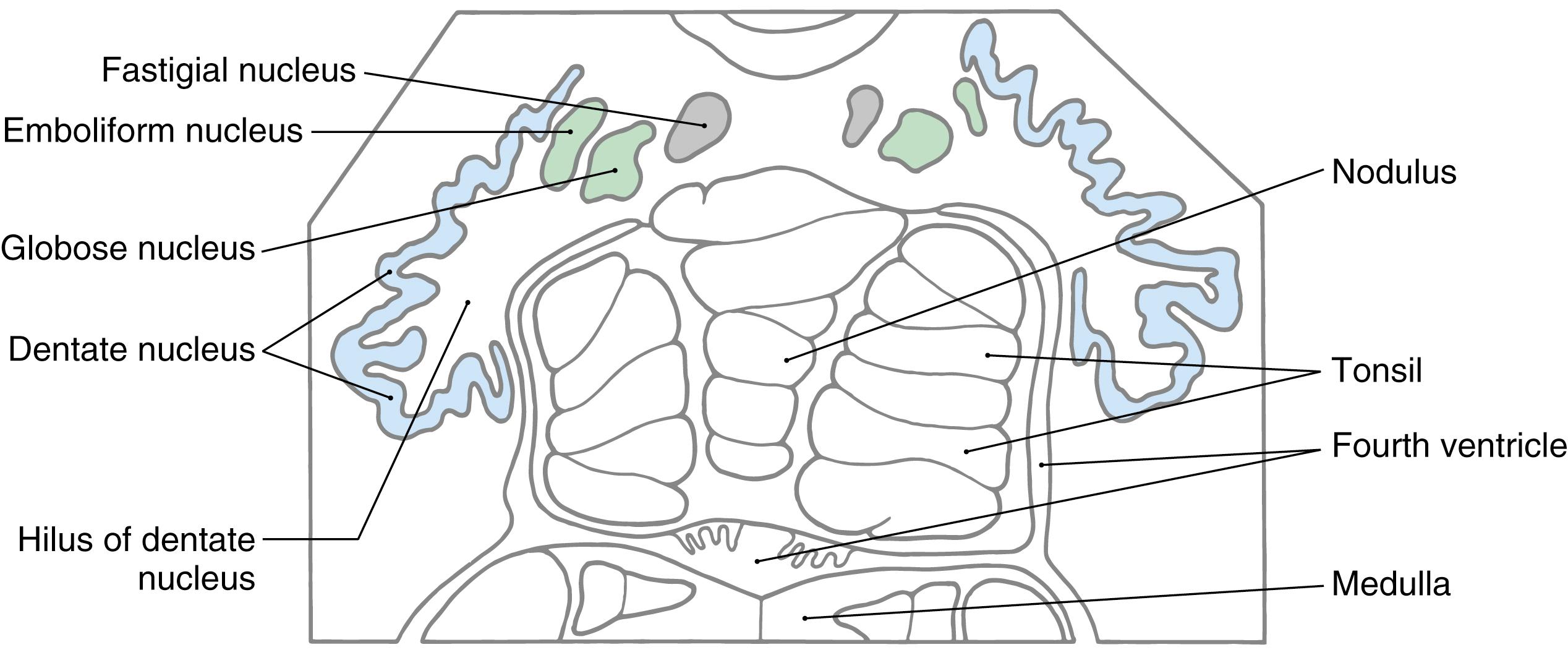
Most of the signals that leave the cerebellum do so via axons that arise in the cerebellar nuclei; the remainder travel on fibers that originate in the cerebellar cortex. Collectively, axons that arise in the cerebellar nuclei constitute cerebellar efferent projections (e.g., cerebellothalamic fibers ). These axons originate from cells in the cerebellar nuclei and generally use one of the excitatory neurotransmitters, glutamate or aspartate, and thus function to activate their targets. The juxtarestiform body contains fibers that arise from the cerebellar cortex, form the cerebellar corticovestibular projection, use the inhibitory neurotransmitter γ-aminobutyric acid (GABA), and inhibit their targets. The fastigial nuclei generally project bilaterally to the brainstem through the juxtarestiform bodies. Fibers originating in the dentate, emboliform, and globose nuclei exit the cerebellum via the superior cerebellar peduncle and cross in its decussation in the caudal midbrain ( Fig. 27.1 ). These axons terminate in brainstem and thalamic nuclei on the contralateral side (see Figs. 27.17 to 27.19 ); their predominant action is to excite their targets.
Some neurons in each cerebellar nucleus send axons or axon collaterals into the overlying cortical zone, where they terminate in the granular layer as mossy fibers. These axons are called nucleocortical fibers, and they exert an excitatory influence on the cerebellar cortex.
The blood supply to the cerebellar cortex, nuclei, and peduncles is via the posterior inferior cerebellar artery ( PICA ), anterior inferior cerebellar artery ( AICA ), and superior cerebellar artery ( SCA ) ( Figs. 27.5 and 27.7 [see pp. 399–400 ]). The PICA originates from the vertebral artery and supplies the posterolateral medulla (including the restiform body), the choroid plexus of the fourth ventricle, and caudomedial regions of the inferior cerebellar surface (including the vermis) ( Figs. 27.5 and 27.7 ). Caudal parts of the middle cerebellar peduncle, the choroid plexus extending out of the foramen of Luschka, and the caudolateral portions of the inferior cerebellar surface are served by the AICA. This vessel may also supply small caudal parts of the dentate nucleus ( Fig. 27.5 ). The entire superior surface of the cerebellum, most of the cerebellar nuclei, the rostral parts of the middle cerebellar peduncle, and the superior cerebellar peduncle are served by the SCA ( Fig. 27.7 ).
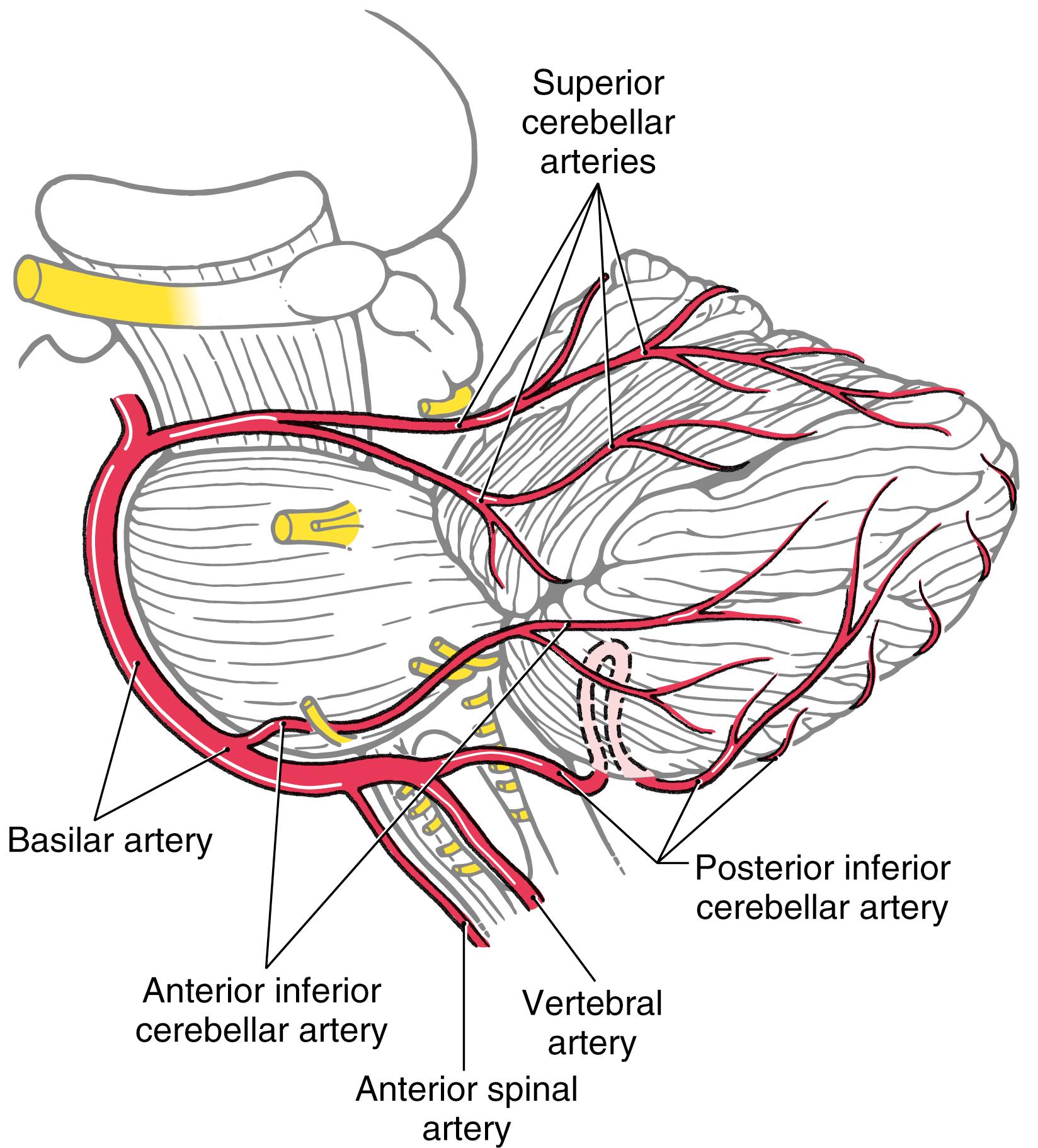
On histologic examination, each folium of the cerebellum has a superficial cellular layer, the cerebellar cortex, and a core of myelinated fibers traveling to ( afferent ) or from ( efferent ) the overlying cortex. The cortex consists of a Purkinje cell layer insinuated between a cell-dense inner region immediately adjacent to the white matter core, the granule cell layer, and an outer pale and relatively cell sparse portion, the molecular layer ( Figs. 27.8 and 27.9 [see pp. 400–401 ]).
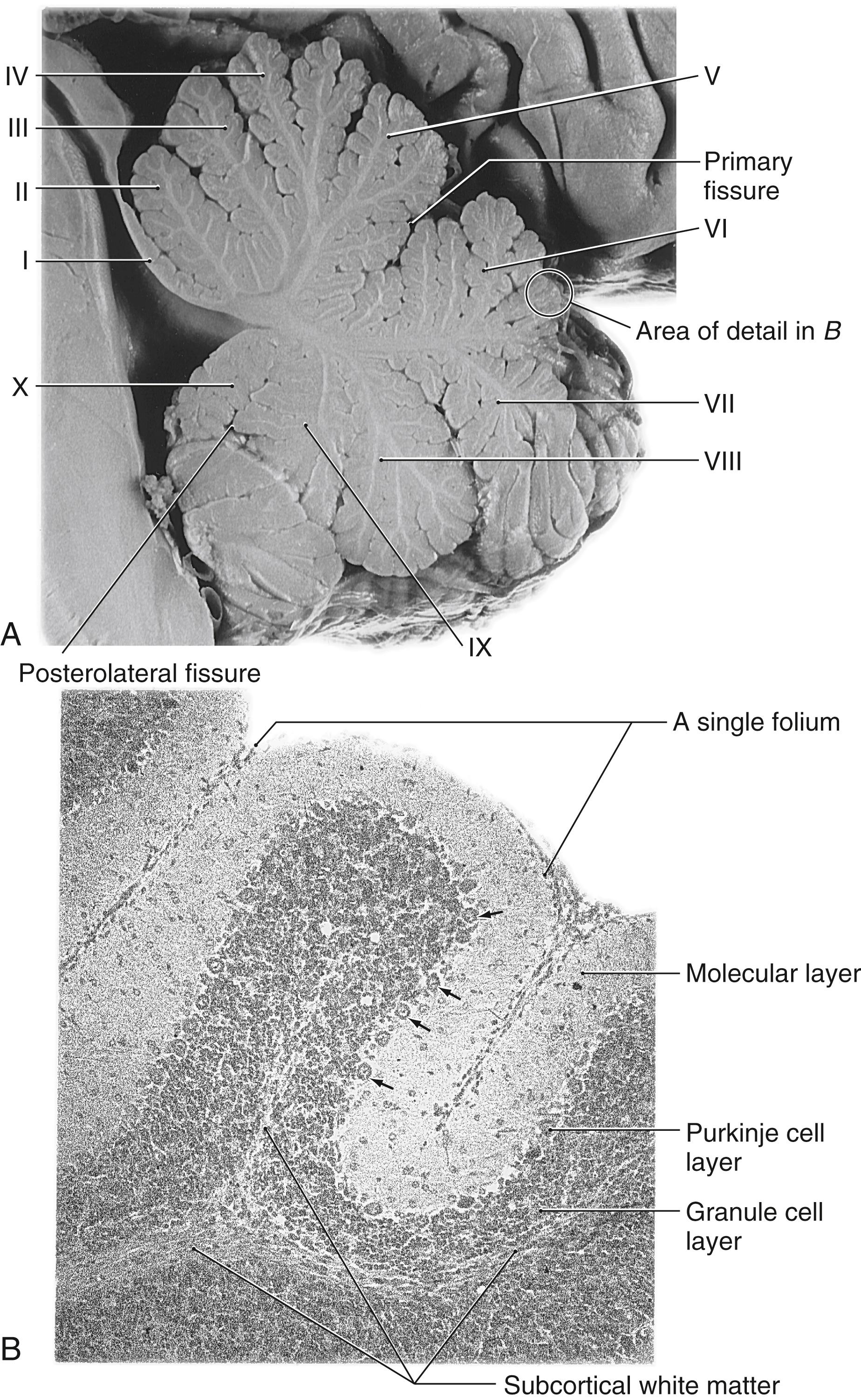
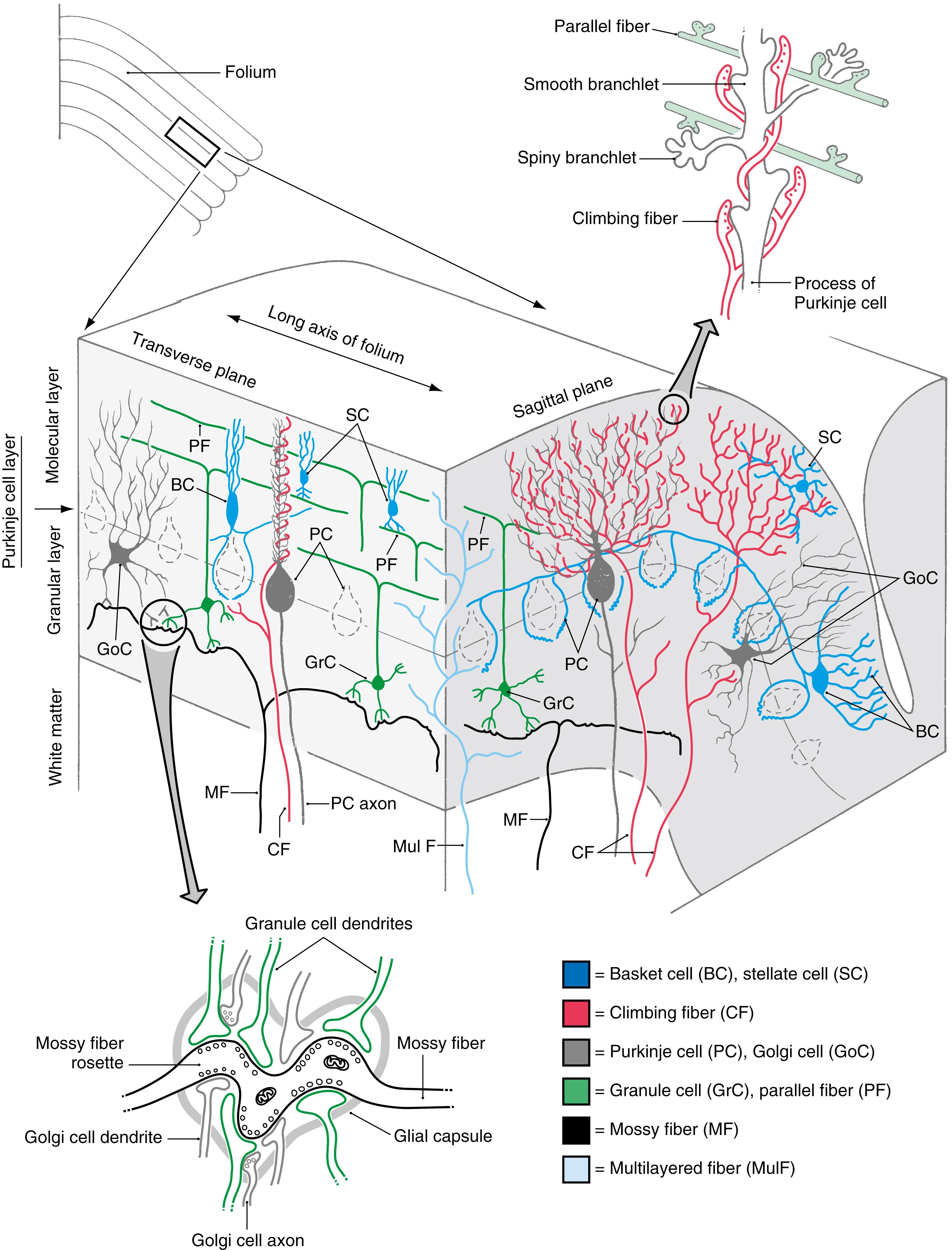
Become a Clinical Tree membership for Full access and enjoy Unlimited articles
If you are a member. Log in here